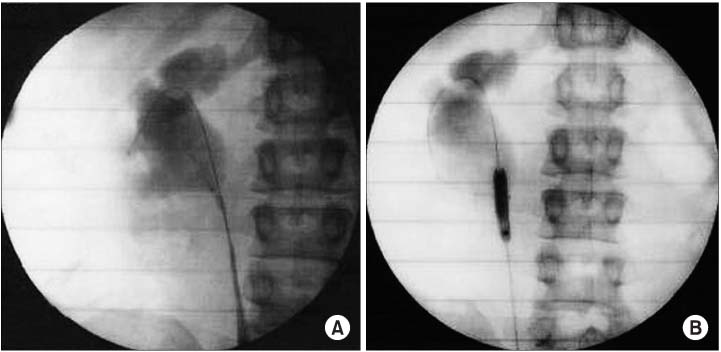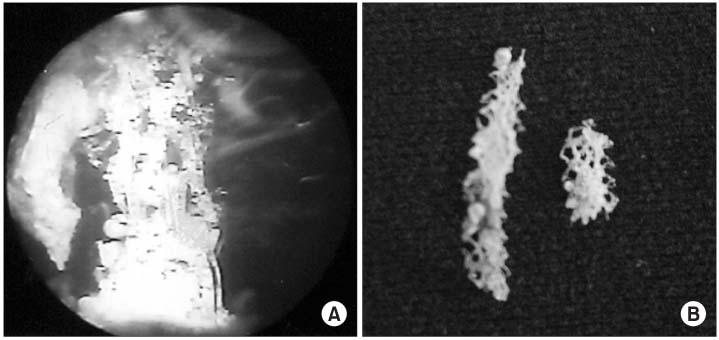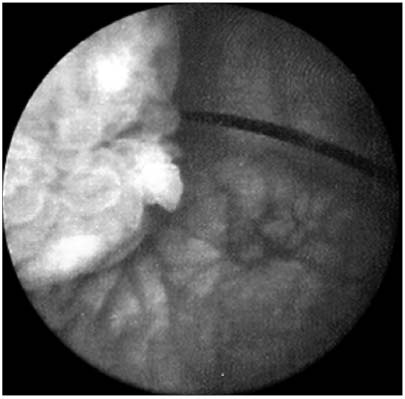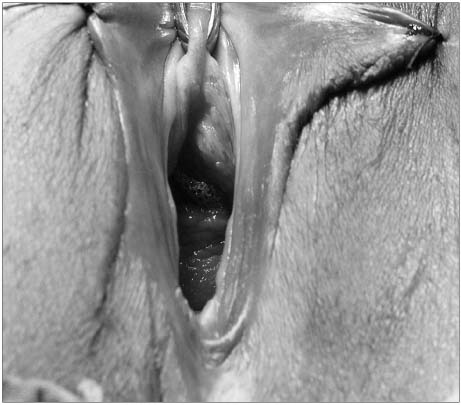Korean J Urol.
2006 Aug;47(8):841-846. 10.4111/kju.2006.47.8.841.
Surgical Intervention for the Complications of the Sling Operation in Patients with Female Stress Urinary Incontinence
- Affiliations
-
- 1Department of Urology, Wonkwang University School of Medicine and Institute of Wonkwang Medical Science, Iksan, Korea. sc.park@wonkwang.ac.kr
- KMID: 2294112
- DOI: http://doi.org/10.4111/kju.2006.47.8.841
Abstract
-
PURPOSE: Stress urinary incontinence is a quality of life issue for millions of women worldwide. Mid-urethral slings are becoming the treatment of choice for the management of stress urinary incontinence. Although it is a minimally invasive procedure, the widespread use of this procedure has led to an increasing number of severe complications. In our series, there were 6 patients with complications that necessitated surgery.
MATERIALS AND METHODS
Six patients underwent the sling procedure and they required surgical intervention for their complications, including permanent urinary retention, de-novo urgency, intravesical polypropylene mesh tape, intravesical suture material, vaginal mucosal erosion, and urethral shortening.
RESULTS
For the patients with urinary retension, they underwent resection of periurethral sling transvaginally. The intravesical tapes were resected by the transurethral approach, and this was supported by suprapubic laparoscopic trocar puncture. The intraravesical suture material was removed by same approach. In the case of vaginal erosion, the periurethral part of the tape was resected transvaginally. A patient with urethral shortening was treated with urethroplasty.
CONCLUSIONS
Complications from the sling operation that require surgical intervention are rare. Nevertheless, the surgeon must be aware that complications may occur that require surgical intervention with high morbidity.
Keyword
MeSH Terms
Figure
Reference
-
1. Westney OL, McGuire EJ. Hurt WG, editor. Pubovaginal slings. Urogynecologic surgery. 2000. 2nd ed. Philadelphia: Lippincott Williams & Wilkins Co;93.2. Sand PK, Bowen LW, Panganiban R, Ostergard DR. The low pressure urethra as a factor for failed retropubic urethropexy. Obstet Gynecol. 1987. 69:399–402.3. Summitt RL Jr, Bent AE, Ostergard DR, Harris TA. Stress incontinence and low urethral closure pressure. Correlation of preoperative urethral hypermobility with successful suburethral sling procedures. J Reprod Med. 1990. 35:877–880.4. Appell RA. Walsh PC, Retik AB, Vaughan ED, Wein AJ, editors. Injection therapy for urinary incontinence. Campbell's urology. 2002. 8th ed. Philadelphia: Saunders;1172–1186.5. Ulmsten U, Petros P. Intravaginal slingplasty (IVS): an ambulatory surgical procedure for treatment of female urinary incontinence. Scand J Urol Nephrol. 1995. 29:75–82.6. Petros P, Ulmsten U. An integral theory of female urinary incontinence. Experimental and clinical considerations. Acta Obstet Gynecol Scand. 1990. 153:Suppl. 7–31.7. The Korean Urological Association. 1984-2002 Urological disease and surgery in urological trainning hospitals: The report of the Korean Urological Association.8. Ward KL, Hilton P, Browning J. A randomized trial of colposuspension and tension free vaginal tape for primary genuine stress incontinence. Neurourol Urodyn. 2000. 19:386–388.9. Smith AR, Santon SL. Laparoscopic colposuspension. Br J Obstet Gynecol. 1998. 105:383–384.10. Haab F, Trockman BA, Zimmern PE, Leach GE. Results of pubovaginal sling for the treatment of intrinsic sphincteric deficiency determined by questionnaire analysis. J Urol. 1997. 158:1738–1741.11. Govier FE, Gibbons RP, Coreea RJ, Weissman RM, Pritchett TR, Hefty TR. Pubovaginal slings using fascia lata for treatment of intrinsic sphincter deficiency. J Urol. 1997. 157:117–121.12. Morgan TO Jr, Westney LO, McGuire EJ. Pubovaginal sling: 4-year outcome analysis and quality of life assesment. J Urol. 2000. 163:1845–1848.13. Kobashi KC, Govier FE. Management of vaginal erosion of polypropylene mesh slings. J Urol. 2003. 169:2242–2243.14. Castillo OA, Bodden E, Olivares RA, Urena RD. Intestinal perforation: an infrequent complication during insertion of tesion-free vaginal tape. J Urol. 2004. 172:1364.15. Kim H, Jeong YB, Park YK. 4 cases with complicaton necessitating surgical correction of tension-free vaginal tape procedure in female stress urinary incontinence. J Korean Continence Soc. 2004. 8:42–44.16. Mcguire EJ, Lytton B. Pubovaginal sling procedure for stress incontinence. J Urol. 1978. 119:82–84.17. Volkmer BG, Nesslauer T, Rinnab L, Schradin T, Hautmann RE, Gottfried HW. Surgical intervention for complications of the tension-free vaginal tape procedure. J Urol. 2003. 169:570–574.18. Bang SI, Lee JZ. Outcomes of tension-free vaginal tape according to postoperative period in the treatment of female urinary incontinence. Korean J Urol. 2004. 45:1121–1125.19. Ku JH, Shin JW, Son H, Oh SJ, Kim SW, Paick JS. Predictive factor for persistent urgency or urge incontinence after tension-free vaginal tape procedure in mixed urinary incontinence. Korean J Urol. 2004. 45:330–336.20. Klutke C, Siegel S, Carlin B, Paszkiewicz E, Kirkemo A, Klutke J. Urinary retention after tension-free vaginal tape procedure: incidence and treatment. Urology. 2001. 58:697–701.21. Bhargava S, Chapple CR. Rising awareness of the complications of synthetic slings. Curr Opin Urol. 2004. 14:317–321.22. Lee SH, Jung HC. Treatment of voiding dysfunction following free vaginal tape procedure for the patient of stress urinary incontinence. Korean J Urol. 2003. 44:901–906.23. Jeffry L, Deval B, Birsan A, Soriano D, Darai E. Objective and subjective cure rates after tension-free vaginal tape for treatment of urinary incontinence. Urology. 2001. 58:702–706.24. Giri SK, Drumm J, Flood HD. Endoscopic holmium laser excision of intravesical tension-free vaginal tape and polypropylene suture after anti-incontinence procedures. J Urol. 2005. 174:1306–1307.25. Oh SB, Hwang SI, Kang TW, Kwon DD, Park KS, Ryu SB, et al. Foreign body induced bladder calculi after anti-incontinence surgery. Korean J Urol. 2005. 46:543–546.26. Lebret T, Lugagne PM, Herve JM, Barre P, Orsoni JL, Yonneau L, et al. Evaluation of tesion-free vaginal tape procedure. Its safety and efficacy in the treatment of female stress urinary incontinence during the learning phase. Eur Urol. 2001. 40:543–547.27. Sweat SD, Itano NB, Clemens JQ, Bushman W, Gruenenfelder J, Mcguire EJ, et al. Polypropylene mesh tape for stress urinary incontinence: complications of urethral erosion and outlet obstruction. J Urol. 2002. 168:144–146.28. Korean Continence Society. Textbook of voiding dysfunction and female urology. 2002. 1st ed. Seoul: Ilchokak;1172–1186.29. Tsivian A, Kessler O, Mogutin B, Rosenthal J, Korczak D, Levin S, et al. Tape related complication of the tension-free vaginal tape procedure. J Urol. 2004. 171:762–764.
- Full Text Links
- Actions
-
Cited
- CITED
-
- Close
- Share
- Similar articles
-
- Assessment of Success Rate of the Sling Operation Using Questionnaire Based Outcome Analysis in Patients with Stress Urinary Incontinence
- The Experience After Operation Using Tension-free Vaginal Tape for Stress Urinary Incontinence
- Sling Operation Using Mersilene Mesh in Female Stress Urinary Incontinence Patients
- Sling Operation for the Genuine Stress Incontinence Patients with Intrinsic Sphincter Dysfunction
- Gortex Patch Sling Operation for Patient with Intrinsic Sphincter Deficiency





